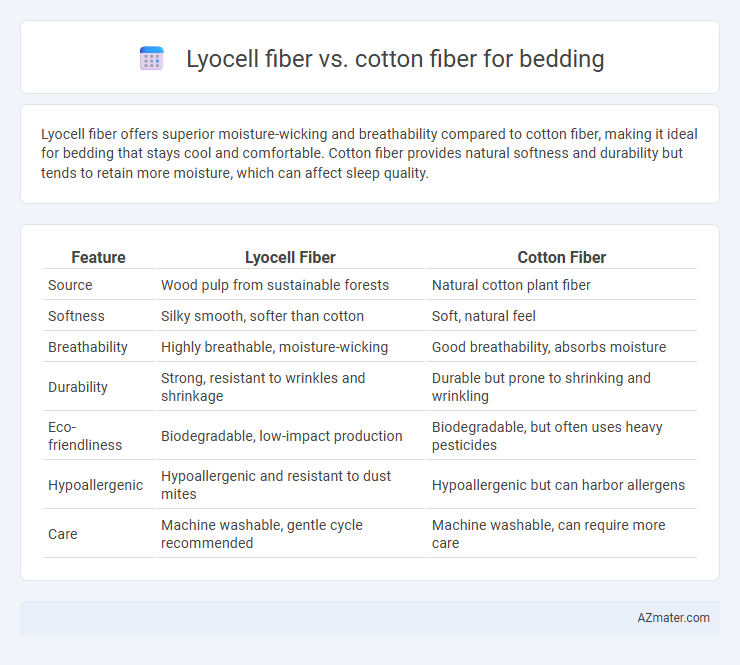Lyocell fiber offers superior moisture-wicking and breathability compared to cotton fiber, making it ideal for bedding that stays cool and comfortable. Cotton fiber provides natural softness and durability but tends to retain more moisture, which can affect sleep quality.
Table of Comparison
| Feature | Lyocell Fiber | Cotton Fiber |
|---|---|---|
| Source | Wood pulp from sustainable forests | Natural cotton plant fiber |
| Softness | Silky smooth, softer than cotton | Soft, natural feel |
| Breathability | Highly breathable, moisture-wicking | Good breathability, absorbs moisture |
| Durability | Strong, resistant to wrinkles and shrinkage | Durable but prone to shrinking and wrinkling |
| Eco-friendliness | Biodegradable, low-impact production | Biodegradable, but often uses heavy pesticides |
| Hypoallergenic | Hypoallergenic and resistant to dust mites | Hypoallergenic but can harbor allergens |
| Care | Machine washable, gentle cycle recommended | Machine washable, can require more care |
Introduction to Lyocell and Cotton Fibers
Lyocell fiber, produced from sustainably sourced eucalyptus wood pulp through a closed-loop process, offers exceptional moisture-wicking and breathability ideal for bedding. Cotton fiber, a natural staple harvested from cotton plants, provides a soft, durable, and hypoallergenic fabric widely used in bedding for its comfort and breathability. Lyocell's environmental benefits and smooth texture contrast with cotton's natural abundance and traditional softness, making both fibers popular choices for high-quality bedding products.
Fiber Origins and Manufacturing Processes
Lyocell fiber originates from sustainably harvested wood pulp, primarily eucalyptus, processed through a closed-loop system that recycles water and solvents, minimizing environmental impact. Cotton fiber is derived from the fluffy seed hairs of the cotton plant, cultivated mainly in regions like the U.S., India, and China, using traditional agricultural methods involving irrigation and pesticides. The Lyocell manufacturing process emphasizes eco-friendly solvents and chemical recovery, contrasting with cotton's reliance on extensive water usage and chemical treatments in harvesting and processing.
Environmental Impact and Sustainability
Lyocell fiber, derived from sustainably sourced eucalyptus trees, features a closed-loop production process that recycles water and solvents, significantly reducing its environmental footprint compared to traditional cotton. Cotton cultivation typically demands extensive water usage and pesticide application, contributing to soil degradation and higher carbon emissions. Lyocell's biodegradability and lower resource intensity make it a more sustainable choice for eco-friendly bedding.
Softness and Comfort Comparison
Lyocell fiber offers superior softness compared to cotton due to its smooth, silk-like texture that reduces skin irritation and enhances comfort during sleep. Cotton, while breathable, tends to be less silky and can feel coarser depending on the weave and quality, impacting overall softness. Bedding made from Lyocell provides better moisture-wicking properties, maintaining a cool and comfortable sleeping environment throughout the night.
Moisture Wicking and Breathability
Lyocell fiber offers superior moisture-wicking properties compared to cotton, efficiently drawing sweat away from the skin to keep sleepers dry and comfortable. Its inherently breathable structure promotes better airflow, reducing heat retention and enhancing sleep quality. Cotton, while breathable, tends to absorb moisture and retain it, which can lead to a damp feel during extended use.
Durability and Longevity
Lyocell fiber offers superior durability compared to cotton fiber due to its strong cellulose structure and resistance to wear, making it an excellent choice for long-lasting bedding. Cotton fibers tend to weaken and pill over time with frequent washing, reducing the fabric's longevity. Lyocell's moisture-wicking and breathable properties contribute to maintaining fiber integrity, ensuring extended use without significant degradation.
Hypoallergenic and Skin-Friendliness
Lyocell fiber, derived from sustainably sourced eucalyptus wood pulp, offers superior hypoallergenic properties compared to traditional cotton fiber, reducing the risk of irritation and allergies for sensitive sleepers. Its moisture-wicking and breathable nature enhances skin-friendliness by maintaining a cool, dry sleeping environment, minimizing bacterial growth and skin discomfort. Cotton bedding, while natural and soft, often retains more moisture and may harbor allergens, making Lyocell a preferred option for those seeking gentle, allergy-resistant sleep textiles.
Maintenance and Care Requirements
Lyocell fiber bedding requires less frequent washing due to its moisture-wicking and antimicrobial properties, making maintenance easier compared to cotton. Cotton fiber bedding, while breathable and soft, tends to absorb moisture and may need more regular laundering to prevent bacteria buildup and maintain freshness. Lyocell also dries faster than cotton, reducing drying time and energy consumption during care.
Cost Considerations and Affordability
Lyocell fiber bedding typically costs more than cotton due to its eco-friendly production process and renewable raw material source. Cotton bedding offers greater affordability, especially in basic or blended forms, making it accessible for budget-conscious consumers. When considering long-term value, Lyocell's durability and moisture-wicking properties may justify its higher initial price compared to the more economical but less durable cotton options.
Choosing the Best Fiber for Your Bedding
Lyocell fiber offers superior moisture-wicking and breathability compared to cotton fiber, making it ideal for hot sleepers and those seeking hypoallergenic bedding. Cotton fiber remains popular for its natural softness, durability, and easy care, but it may retain more moisture than Lyocell, potentially leading to discomfort in humid conditions. Choosing the best fiber depends on preferences for temperature regulation, environmental sustainability, and maintenance, with Lyocell providing eco-friendly benefits through its closed-loop production process.

Infographic: Lyocell fiber vs Cotton fiber for Bedding
 azmater.com
azmater.com